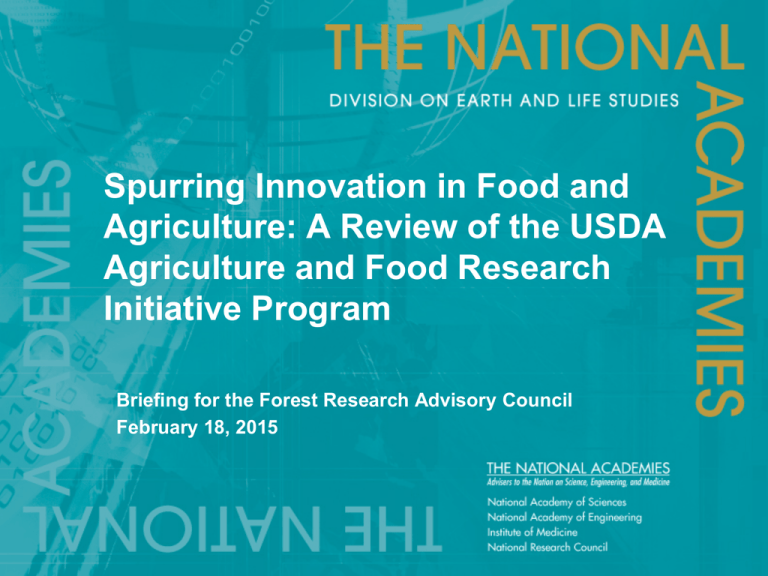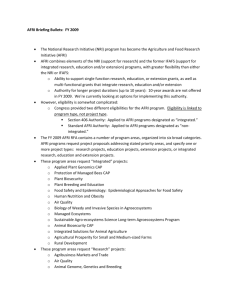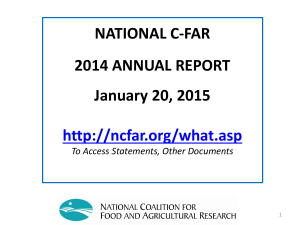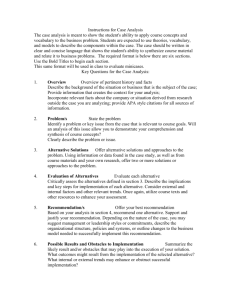Spurring Innovation in Food and Agriculture: A Review of the USDA
advertisement

Spurring Innovation in Food and Agriculture: A Review of the USDA Agriculture and Food Research Initiative Program Briefing for the Forest Research Advisory Council February 18, 2015 Welcome The report is available online at http://www.nap.edu/catalog.php?record_id=18652 2 Study Committee COMMITTEE VICTOR L. LECHTENBERG (Chair), Purdue University, Lafeyette, IN STEVEN S. BALLING, Del Monte Foods, Walnut Creek, CA KEITH L. BELLI, University of Tennessee, Knoxville, TN PETER J. BRUNS, Howard Hughes Medical Institute (retired), Chevy Chase, MD STEVEN T. BUCCOLA, Oregon State University, Corvallis, OR JAMES C. CARRINGTON, Danforth Plant Science Center, St. Louis, MO MACHI F. DILWORTH, National Science Foundation (retired), Arlington, VA CUTBERTO GARZA, Boston College, Chestnut Hill, MA RONNIE D. GREEN, University of Nebraska–Lincoln, Lincoln, NE ROSEMARY R. HAGGETT, University of North Texas System, Dallas, TX GENE HUGOSON, University of Minnesota, St. Paul, MN BENNIE I. OSBURN, University of California, Davis, CA PHILLIP G. PARDEY, University of Minnesota, St. Paul, MN SALLY J. ROCKEY, National Institutes of Health, Bethesda, MD JULIANA M. RUZANTE, Pew Charitable Trusts, Washington, DC JAMES J. ZUICHES, North Carolina State University (retired), Chapel Hill, NC 3 Committee Asked to… Statement of Task (see Box S-1 on page 2 of report) Assess the AFRI Program • value of research funded by the program (outputs) • prospects for its success in meeting desired goals and outcomes (resources) • role of AFRI relative to other federal R&D programs, such as NSF, NIH, and DOE (portfolio) • Effectiveness, fairness, functioning (priority-setting process, diversity, program management) Committee did not • make recommendations about funding levels for AFRI • review USDA’s entire research, extension, and education portfolio • compare AFRI to other USDA programs (intramural and extramural) and funding mechanisms (formula and competitive grants). Such an assessment of the role and importance of competitive funds relative to formula grants was beyond the scope of this study. 4 Study Approach Types of information considered • Data on AFRI from 2009-2012 provided by NIFA • Additional information requests to NIFA and follow-up questions • Individuals who contributed to the conceptualization and implementation of NIFA and AFRI, government agencies, professional societies, and grantees of AFRI • Comments from researchers, academic and extension leaders, reviewers, and users and beneficiaries of AFRI Ways for gathering additional information • Committee meetings (see Appendix B for presentations to the committee) • Web-based questionnaire for broadly soliciting input (used for informing the committee, but not used in any statistical or quantitative manner for the committee’s review) (see Appendix C and D) Origins of AFRI Farm Bills as they relate to AFRI • • • • • AFRI mandated by the 2008 Food, Conservation, and Energy Act (aka 2008 Farm Bill) AFRI authorized for $700M – Although $190-291M appropriated (FY 2008-2014) 2008 Farm Bill established a complex set of goals within six priority areas: – plant health and production and plant products; – animal health and production and animal products; – food safety, nutrition, and health; – renewable energy, natural resources, and environment; – agriculture systems and technology; and – agriculture economics and rural communities 2008 Farm Bill specified split of 60:40 for fundamental vs. applied research 2014 Farm Bill: reaffirms importance of AFRI, no changes in priority areas – Sidenote: provision requiring non-land grant universities to match funds for AFRI, which occurred just as the committee was finishing its review of AFRI. REPORT CONCLUSIONS AND RECOMMENDATIONS 7 Recommendation 1 Need for Food and Ag Research • CONCLUSION 1: AFRI plays a critical and unique role in the nation’s overall R&D portfolio because its mandated scope, mission, and responsibilities are focused on the most important national and international challenges facing food and agriculture. But it has not been adequately given the resources needed to meet contemporary and likely future challenges. • RECOMMENDATION 1: The United States should strengthen its public investment in competitive agricultural R&D to ensure that it continues its role of a global leader in the innovations and technologies that are needed to promote health and well-being and to feed growing worldwide populations sustainably. 8 Recommendation 2 Realignment of Program Structure to Match Mission, Mandate, and Budget • CONCLUSION 2: AFRI is unnecessarily complex, difficult to depict clearly, and characterized by overlapping components that do not clearly align with priorities identified in authorizing legislation. • RECOMMENDATION 2: NIFA should simplify the AFRI program structure by realigning it to more clearly address its specific mission and mandates as defined in authorizing legislation. 9 Recommendation 2 (cont’d) Rebalancing the Portfolio Recommendation 2-A: To realign AFRI’s portfolio with its legislative mandate, NIFA should renew its priority for fundamental research. That should include an emphasis on proposals that will generate fundamental knowledge to support novel technologies, provide platforms for extension and education, and educate the next generation of food and agricultural scientists. The Challenge-Area Program Recommendation 2-B: As part of its realignment, AFRI should be simplified by eliminating the Challenge-Area Program, and areas of research within the Foundational Program should be primarily investigator driven. 10 Recommendation 3 Strategy and Collaboration • CONCLUSION 3: AFRI does not have clearly articulated plans to guide its priority-setting, management processes, and interagency collaboration. • RECOMMENDATION 3: AFRI should develop a strategic plan that identifies priorities for its overall program, goals for meeting them, and a framework for assessing the program’s progress. 11 Recommendation 3 (cont’d) Interagency Collaboration • Recommendation 3-A: NIFA and USDA should lead interagency efforts to effectively coordinate and collaborate across agencies on food and agricultural research. External Advisory Council • Recommendation 3-B: NIFA should form an AFRI Scientific Advisory Council that consists of members who represent the food and agricultural research, education, and extension professional communities. 12 Recommendation 4 Program Management • CONCLUSION 4: AFRI’s complex and diffuse management structure has made it difficult to efficiently and effectively manage the program. • RECOMMENDATION 4: To enhance program accountability and management, AFRI should have a dedicated leader who manages the program on a daily basis. 13 Recommendation 4 (cont’d) Agriculture and Food Research Initiative Director • Recommendation 4-A: NIFA should establish a clearer organizational structure and lines of authority for AFRI, including a designated director to lead, manage, and speak for its program, and NPLs dedicated to AFRI alone. Program Continuity and Transparency • Recommendation 4-B: NIFA should have a more consistent and predictable program portfolio and funding strategy to enable better planning by the food and agricultural research community. Data Management • Recommendation 4-C: NIFA should use a more robust information-management system that would provide a basis for AFRI policy and strategic planning. The system should allow detailed assessment and management of the food and agricultural competitive research funding pool. 14 Recommendation 4 (cont’d) Post-Award Management • Recommendation 4-D: NIFA should develop the capability to regularly evaluate AFRI projects in terms of their outcomes, which would allow assessment of the economic and social impacts of the research that AFRI supports. Greater Authority for National Program Leaders • Recommendation 4-E: NIFA should establish standard operating procedures that provide greater opportunity for NPLs to contribute to final project-funding decisions. 15 16





